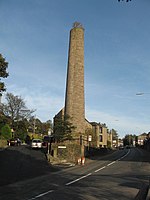Grotton and Springhead railway station
Disused railway stations in the Metropolitan Borough of OldhamFormer London and North Western Railway stationsGreater Manchester railway station stubsPages with no open date in Infobox stationRailway stations in Great Britain closed in 1955 ... and 2 more
Railway stations in Great Britain opened in 1856Use British English from June 2017

Grotton and Springhead railway station served the villages of Grotton and Springhead from 1856 until 1955.
Excerpt from the Wikipedia article Grotton and Springhead railway station (License: CC BY-SA 3.0, Authors, Images).Grotton and Springhead railway station
Carrefour de la Croix Catelan, Paris Paris 16e Arrondissement (Paris)
Geographical coordinates (GPS) Address Nearby Places Show on map
Geographical coordinates (GPS)
| Latitude | Longitude |
|---|---|
| N 53.5355 ° | E -2.0553 ° |
Address
Carrefour de la Croix Catelan
Carrefour de la Croix Catelan
75016 Paris, Paris 16e Arrondissement (Paris)
Île-de-France, France
Open on Google Maps






